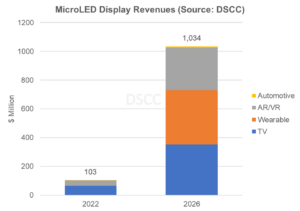The market for MicroLED displays will quickly grow to surpass $1B in revenues in the next five years, according to DSCC’s new MicroLED Display Technology and Market Outlook Report. While MicroLED will generally remain a niche display technology in consumer electronics, it will be adopted in three major applications: TV, Wearables and AR/VR.
MicroLED displays are based on light emitting diodes (LED) that are smaller than 100 ?m. At this size, it becomes possible to pack enough pixels per unit area to produce high resolution self-emissive displays. MicroLEDs are even smaller than MiniLEDs, which are currently used in LCD backlights.
“MicroLED offers several advantages over LCD and OLED, including higher efficiency, higher brightness, faster response and longer lifetime. However, cost remains a challenge. The 110” MicroLED TV manufactured by Samsung is still priced above $120,000. The DSCC report explores the different cost factors and the various strategies to reduce them,” said Guillaume Chansin, Director of Display Research at DSCC.
Samsung is currently working with its partners to release cheaper TV models. We expect the resolution to remain at 4K to avoid the significant increase in material cost with 8K. This could make it more difficult to position the MicroLED range as “future proof” and the best money can buy.
Despite these challenges, DSCC expects revenues for MicroLED displays to increase ten-fold within a four-year period, from $103M in 2022 to over $1B in 2026. This scenario assumes the introduction of wearable devices based on MicroLED instead of OLED panels.
Source: DSCC’s MicroLED Display Technology and Market Outlook Report
For AR/VR, the displays will be manufactured in a monolithic fashion to achieve a high pixel density. MicroLED can offer the high brightness required for smart glasses without the need for an external illumination source, thereby maintaining a small footprint. Several OEMs have already demonstrated prototype smart glasses based on MicroLED.
The new DSCC report will be valuable to anyone in the display supply chain and end users who may want to adopt MicroLED displays in future products. It lists the OEMs currently developing products incorporating MicroLED displays and provides shipment and revenue forecasts for each application.
The report addresses all the important topics on MicroLED, including:
- Epitaxy and efficiency challenges;
- Mass transfer technologies;
- Yield and defect management strategies;
- Color conversion with quantum dots;
- Backplanes and driving schemes;
- Monolithic displays;
- Cost analysis (epiwafers, backplanes, QD color conversion, transfer costs);
- Competitive landscape;
- Market forecasts to 2026 (shipments and revenues).
Companies covered in the report include: Samsung, Apple, Meta (formerly Facebook), Snap, Vuzix, PlayNitride, AUO, Foxconn, Ennostar, X Display, VueReal, Coherent, Kulicke & Soffa (K&S), eLux, Nanosys, Aledia, MICLEDI and Jade Bird Display.

